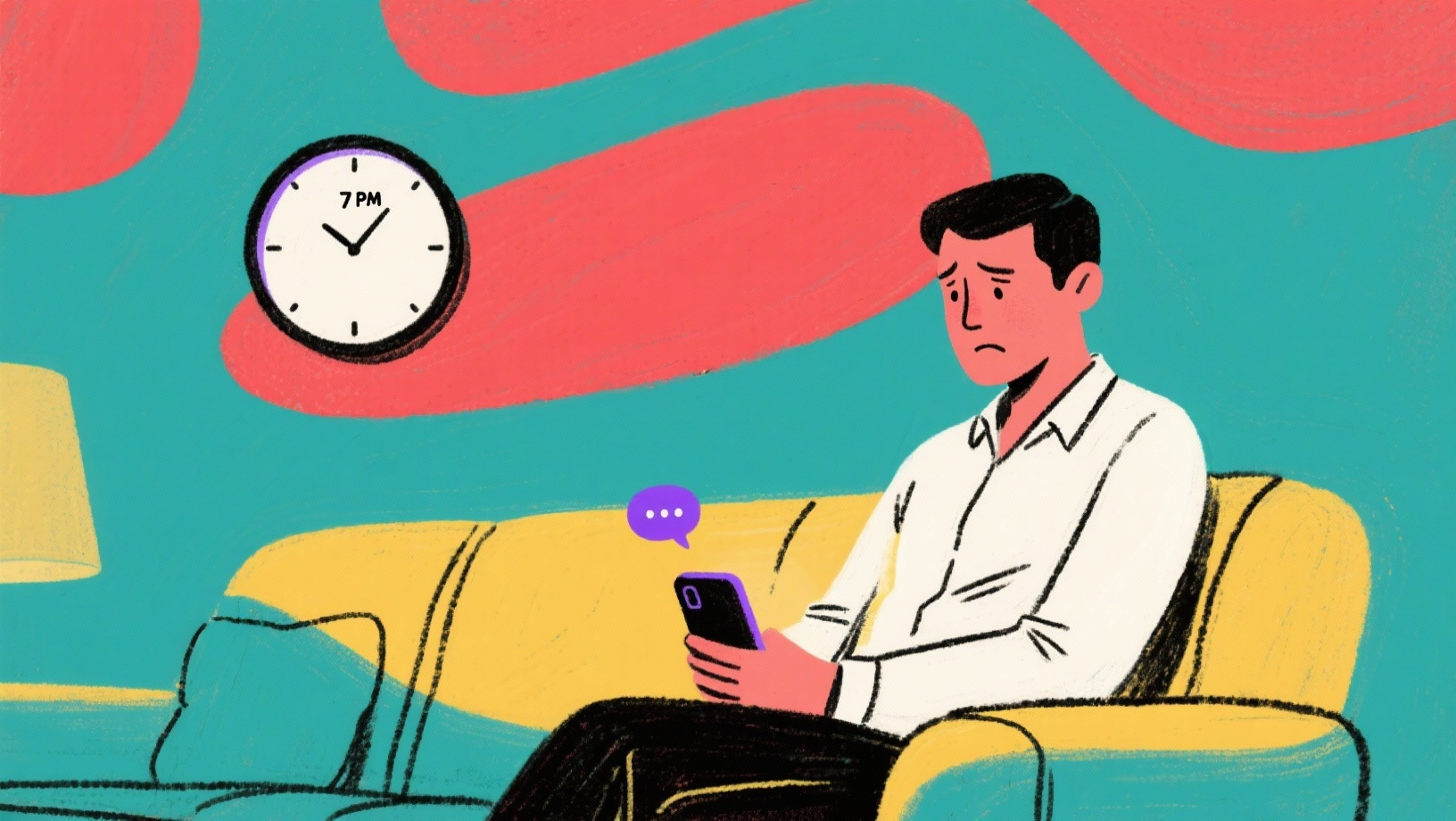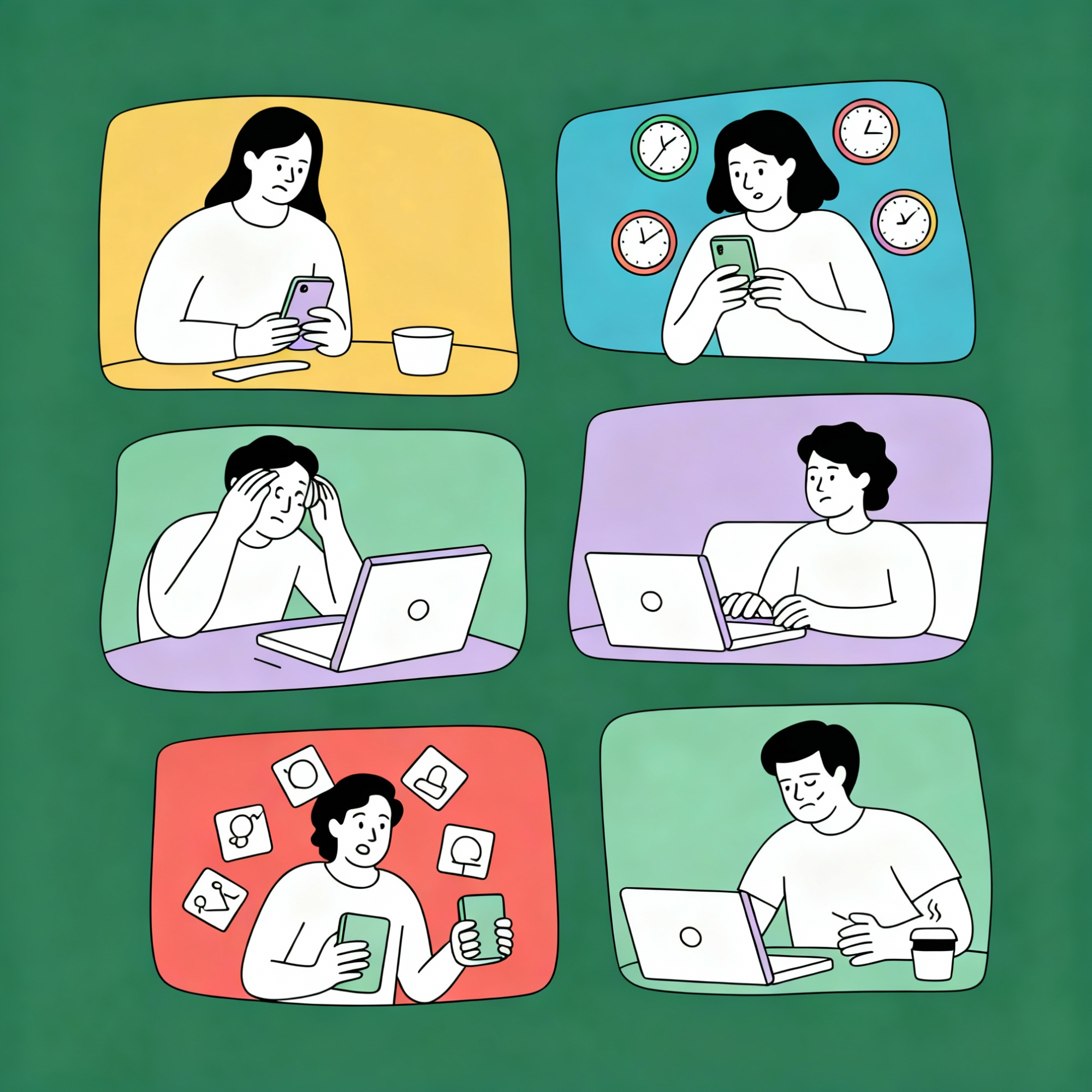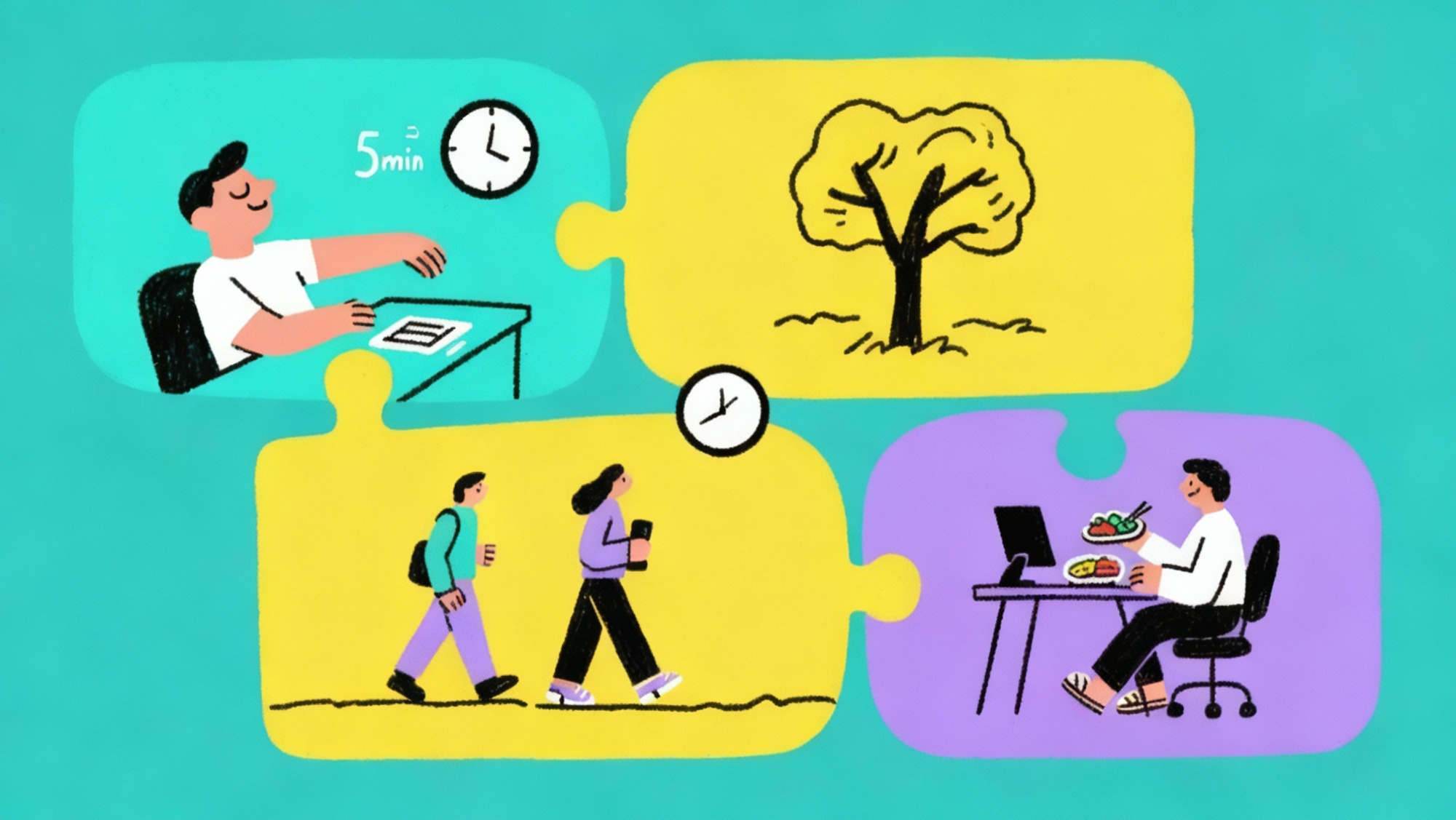Key Takeaways
- Stress isn't personal, it's structural: One in three professionals experience high stress, driven by modern work patterns like always-on connectivity, compressed timelines, and the pressure to always appear busy.
- The business case is clear: Chronic stress increases healthcare costs, drives down productivity, and accelerates attrition, directly impacting your organization's performance and budget.
- Small changes create big returns: Organizations that build recovery into workflows, redesign meeting norms, and model healthier behaviors see measurable gains in productivity, talent retention, and cost control.
{{divider}}

It Starts on Sunday Night
Sunday evening, around 7 PM, a familiar knot in your stomach returns. The weekend is ending, and tomorrow is Monday. Your mind starts racing through the week ahead: back-to-back meetings, pending deliverables, that presentation you haven't started, 47 unread Slack messages waiting on your phone.
We've normalized this feeling so much that we gave it a name: the "Sunday Scaries." But what this really signals is that work has become stressful by default, not by exception.
By Monday morning, the stress is fully activated. The alarm goes off, and within minutes you're already behind, checking emails before breakfast, mentally mapping your day, feeling the pressure before you've even logged on. The week hasn't started, but the exhaustion already has.
Our Workforce Health Index (WHI) 2025 reveals that 33.9% of professionals report high stress, with women experiencing 17% higher stress levels than men. These numbers aren't just about people who "can't handle pressure." They point to something deeper: patterns embedded in how modern work operates.
Workplace stress isn't a personal problem. It's a design problem.
{{divider}}

How We Got Here: Five Forces Shaping Modern Work
Nobody woke up one day and decided to build stressful workplaces. These patterns emerged gradually, shaped by market pressures, digital transformation, and the race to stay competitive. Organizations now face the consequences: rising insurance claims, burnt-out teams, and talent walking out the door.
The encouraging part? Just as stress got designed into work, recovery can be designed back in.
1. Always Connected, Never Off
Slack notifications at dinner. WhatsApp groups are buzzing on weekends. Teams calls during what used to be family time. Work no longer stays at work; it follows us home, on vacation, and into every quiet moment.
Microsoft's Work Trend Index found that after-hours work jumped 28% globally after the pandemic. In India, where long hours were already normalized, this shift has locked employees into a cycle of perpetual availability.
The cost extends beyond time. It's about losing the ability to truly disconnect, as even during off hours, minds stay in work mode, monitoring messages and anticipating requests. That Sunday evening dread starts earlier each week because the boundary between work time and personal time has disappeared.
2. Why Everything Feels Urgent
Quarterly targets have been compressed into weekly sprints. Projects that once allowed breathing room now operate on "urgent" timelines. Teams juggle overlapping deadlines with little recovery time between tasks.
This pattern didn't happen by accident. Urgency gets rewarded, and employees who deliver under pressure receive praise, while those who advocate for sustainable pacing risk appearing uncommitted. Speed has become the metric that matters most.
Research in organizational psychology shows what comes next: more errors, higher turnover, and diminished creativity. Organizations burn through short bursts of productivity at the expense of long-term capacity. Monday morning stops being the start of a productive week. It becomes the beginning of another sprint toward Friday.
3. When Home Became the Office
Remote work promised flexibility. For many employees, it delivered something different. Homes transformed into extensions of the office.
In cities like Mumbai, remote workers report stress levels of 6.1 on a 10-point scale, even though they exercise more than purely office-based employees. Companies are starting to notice these patterns. Infosys introduced automated HR reminders when remote employees work more than 9 hours and 15 minutes in a day.
Researchers call this "boundaryless stress." It's the mental load of being perpetually available. Not just longer hours, but the erosion of recovery time altogether. Your bedroom doubles as your office, so even sleep stops feeling like true rest.

4. More Tools, More Complexity
Digitalization was supposed to simplify work. In practice, it fragmented work into smaller, more frequent tasks. Employees now toggle between multiple platforms just to complete a single task: Salesforce, Slack, internal analytics dashboards, project management tools, and more.
Automation introduced new pressures. Productivity trackers and keystroke monitors create the need to always appear active. While designed to boost efficiency, these tools can erode trust and add to mental load.
Continuous upskilling has become mandatory just to keep pace. The sense of "catching up" never ends. For many professionals, change itself has become the stressor. Every Monday brings not just work, but the pressure to learn new systems, adapt to new processes, and stay relevant.
5. The Myth That Busyness Equals Productivity
In many workplaces, presence still gets mistaken for performance. Staying online late, answering emails at midnight, being the last one in a Zoom call gets celebrated as "commitment."
Our Workforce Health Index shows 33.9% of professionals operate in high-stress mode, with 41.2% of women reporting chronic high stress. A Deloitte survey reinforces this concern: 77% of Indian professionals report feeling burnt out at their current job, with nearly half citing long hours as the primary driver.
Indian employees work an average of 48 to 50 hours per week, among the highest globally. Instead of rewarding efficiency, workplaces continue to reward endurance. Busyness becomes proof of loyalty. Recovery gets mistaken for laziness.
Monday blues aren't just about preferring weekends. They're about dreading a system that equates exhaustion with excellence.
{{divider}}
The Real Cost of Stress
(And Why Finance Teams Should Care)

For too long, stress was treated as a "soft" issue, something for wellness programs to handle with yoga sessions and meditation apps. The reality is harder and more measurable than that.
Health Impact
Chronic stress elevates cortisol levels, disrupting cardiovascular health, blood pressure, glucose metabolism, and immune response. The Workforce Health Index 2025 shows the scale of this problem:
- 37.2% of professionals show abnormal glucose metabolism, an early warning sign for diabetes
- Over one in three women is clinically anemic, with stress-related fatigue worsening this burden
The World Health Organization links long working hours to a 35% higher risk of stroke and 17% higher risk of heart disease. Indian professionals face a particular vulnerability: these conditions appear two decades earlier compared to peers in developed nations. By their mid-40s, many professionals are already experiencing biological effects that limit healthy, productive years.
That Monday morning exhaustion isn't just emotional, it's biological. Stress that never gets a chance to reset keeps the body in crisis mode week after week.
Productivity Drag
Stress reduces focus, memory, and creativity. Employees under strain make more errors and spend longer reworking tasks. Harvard research shows that presenteeism (working while unwell) costs more than absenteeism because people are present but underperforming. In knowledge-driven roles, this creativity deficit compounds quickly into missed opportunities and lower output.
Teams that start Monday already depleted can't deliver their best work. They're managing stress instead of solving problems.
Rising Healthcare Costs
Stress drives demand for both mental health support and chronic disease care. For CFOs, this shows up as rising insurance claims and medical inflation, already at 14% annually in India. Stress-linked conditions like hypertension and diabetes amplify financial strain by increasing both the frequency and cost of claims.
Talent Drain
Burnt-out employees are more likely to quit. Younger professionals especially cite stress as a reason for switching jobs. Attrition carries steep costs: direct expenses include recruitment and onboarding, while indirect costs include lost expertise and disrupted team dynamics.
Employees who dread Monday morning every single week eventually start looking for Tuesday somewhere else.
{{divider}}
Why Individual Solutions Fall Short
Walk into most companies and you'll find wellness offerings: meditation apps, gym memberships, resilience training workshops. These interventions help, but they don't solve the core problem.
Employees don't lack coping skills. Coping has become a full-time job.
You can't meditate your way out of 50 unread emails. You can't yoga your way through unsustainable deadlines. If the structure of work creates stress faster than individuals can manage it, personal solutions will always fall short.
Sunday evening dread won't disappear because employees download a mindfulness app. It disappears when Monday mornings become manageable.
{{divider}}
What Actually Works: Building Recovery Into Work
HR and leadership teams face a real challenge. Between managing costs, driving performance, and maintaining culture, redesigning work norms can feel like one more impossible task on an already overwhelming list.
Forward-thinking organizations are discovering something valuable: small, targeted interventions create outsized returns. You don't need to overhaul everything at once. You need to start somewhere.
1. Redesign Monday (and the Rest of the Week)
Some organizations are piloting "slow start Mondays," with no meetings before 10 AM. This gives teams time to plan their week without immediate pressure. Others protect Monday afternoons for deep work, preventing the day from becoming a back-to-back meeting marathon.
Additional meeting norms that work include:
- Capping meetings at 25 or 50 minutes (not 30 or 60) to build in transition time
- Creating "core collaboration hours" where meetings happen, protecting focused work time outside those windows
- Piloting one no-meeting afternoon per week across the organization
These changes require minimal budget but create immediate breathing room. Teams that can approach Monday with structure instead of chaos find the entire week shifts.
2. Make Recovery Visible
Leadership behavior cascades through teams. This includes:
- Taking lunch breaks away from desks
- Blocking "focus time" on calendars
- Mentioning evening plans or family commitments openly
During Loop's Stepathon, participation jumped 40% after leadership visibly took walking breaks. Small signals create cultural permission. If the CEO admits to Sunday Scaries and talks about managing them, employees feel less alone and more willing to set boundaries.
3. Build Micro-Recovery Into Workflows
Recovery doesn't require hour-long gym sessions. It happens in small moments throughout the day:
- Five-minute breaks between back-to-back calls
- Walking meetings for one-on-ones
- Stepping away from desks during lunch
- "Reset rituals" that help transition between tasks: a short walk, a few deep breaths, closing one browser tab before opening another
These aren't luxuries, but rather are productivity tools that prevent burnout. Teams that recharge during the week don't arrive at Friday (or Sunday evening) completely depleted.
4. Normalize Workload Conversations
Train managers to proactively check in on workload, not just deliverables. Create psychological safety for employees to say "This timeline isn't realistic" without being labeled as uncommitted.
Some organizations use simple weekly check-ins: "On a scale of 1 to 10, how sustainable does your workload feel right now?" Patterns emerge quickly, allowing for redistribution before burnout hits.
Treat "I'm dreading Monday because of this project timeline" as valuable data, not a personal weakness.
5. Track What Matters
Move beyond activity metrics (hours logged, emails sent) toward outcome metrics (projects completed, quality of deliverables, team health scores).
Behavior follows measurement. If face time stops being the primary metric, employees feel less pressure to perform busyness. Monday becomes about meaningful work, not performative presence.
6. Invest in Systemic Wellness
Programs like Stepathon that gamify activity, build social connection, and require minimal HR effort create cultural momentum. Access to medical advisors, mental health professionals, and preventive health checks through employer benefits catch stress-related risks early.
The best wellness programs don't just help employees cope with stress. They help organizations design it out.
{{divider}}
The Hard Part
HR leaders aren't blind to these patterns. Many see the stress data in their teams and recognize that something needs to change. You notice multiple team members calling in sick on Mondays. You see the attrition reports. You hear the exhaustion in town halls.
But changing embedded norms requires buy-in from leadership, budget for new programs or tools, time to pilot solutions, and willingness to challenge legacy measures of performance. All while maintaining day-to-day operations.
The shift doesn't happen overnight. Organizations that start small (one protected afternoon, one walking meeting, one workload conversation) create momentum. Over time, small changes compound into cultural transformation.
{{divider}}
Frequently Asked Questions
Q: Won't reducing stress mean lower productivity?
Research shows the opposite. Chronic stress reduces focus, creativity, and accuracy. Recovery builds capacity for better performance, not less. Teams that start Monday refreshed deliver more than teams that start Monday depleted.
Q: How do we convince leadership that this matters?
Show the data: rising claims costs, attrition rates, and productivity drag. Frame stress as a business issue with measurable ROI, not a soft HR concern. Monday morning absenteeism alone tells a compelling story.
Q: What if our industry is inherently high-pressure?
High-pressure work doesn't require unsustainable norms. Investment banking, emergency medicine, and tech startups have all piloted recovery-focused interventions without sacrificing performance. The question isn't whether your work is demanding. It's whether your team can sustain the demand long-term.
Q: Where can small companies with limited budgets start?
Meeting norms, workload conversations, and leadership modeling require zero budget. Start there before investing in programs. Even asking "How are you feeling about Monday?" creates psychological safety.
Q: How long before we see results?
Some changes show impact immediately. Meeting-free Monday mornings reduce calendar stress the first week. Others, like shifting culture around busyness, take quarters to embed. Small wins build momentum. The first time someone says "I didn't dread Monday this week," you'll know it's working.
{{divider}}
The Bottom Line
Stress has become the default at work because modern work patterns (always-on connectivity, compressed timelines, blurred boundaries, and glorification of busyness) have hardwired it into professional life. Sunday Scaries have become a cultural norm because Monday mornings have become unsustainable.
But just as stress got designed into work, recovery can be designed back in. For organizations managing large workforces, rising costs, and competitive talent markets, the choice is increasingly clear: treat stress as a systemic business issue, not an individual flaw.
The shift starts small. One protected Monday morning. One walking meeting. One honest conversation about workload. Over time, these changes compound into something bigger: a workplace where people can perform sustainably, not just urgently. Where Monday becomes the start of a productive week instead of the continuation of Sunday evening dread.

Explore the full findings of the India Workforce Health Index, Loop's flagship report: https://whi.loophealth.com
{{divider}}
References
- Loop Health. (2025). Workforce Health Index 2025. Retrieved from https://whi.loophealth.com
- Microsoft. (2021). Work Trend Index: The Next Great Disruption Is Hybrid Work. Microsoft Corporation.
- World Health Organization & International Labour Organization. (2021). WHO/ILO Joint Estimates of the Work-related Burden of Disease and Injury, 2000–2016: Global Monitoring Report. Geneva: World Health Organization.
- Deloitte India. (2023). Women @ Work 2023: A Global Outlook. Deloitte Touche Tohmatsu India LLP.
- Indian Council of Medical Research. (2023). ICMR-NCD Risk Factor Survey Phase II (2022-23). New Delhi: ICMR.
- Hemp, P. (2004). Presenteeism: At Work—But Out of It. Harvard Business Review, 82(10), 49-58.
- Claessens, B. J., Van Eerde, W., Rutte, C. G., & Roe, R. A. (2007). A review of the time management literature. Personnel Review, 36(2), 255-276.
- Allen, T. D., Golden, T. D., & Shockley, K. M. (2015). How Effective Is Telecommuting? Assessing the Status of Our Scientific Findings. Psychological Science in the Public Interest, 16(2), 40-68.
- Mark, G., Gudith, D., & Klocke, U. (2008). The cost of interrupted work: More speed and stress. Proceedings of the SIGCHI Conference on Human Factors in Computing Systems, 107-110.
- Bakker, A. B., & Demerouti, E. (2017). Job demands–resources theory: Taking stock and looking forward. Journal of Occupational Health Psychology, 22(3), 273-285.



.jpg)












